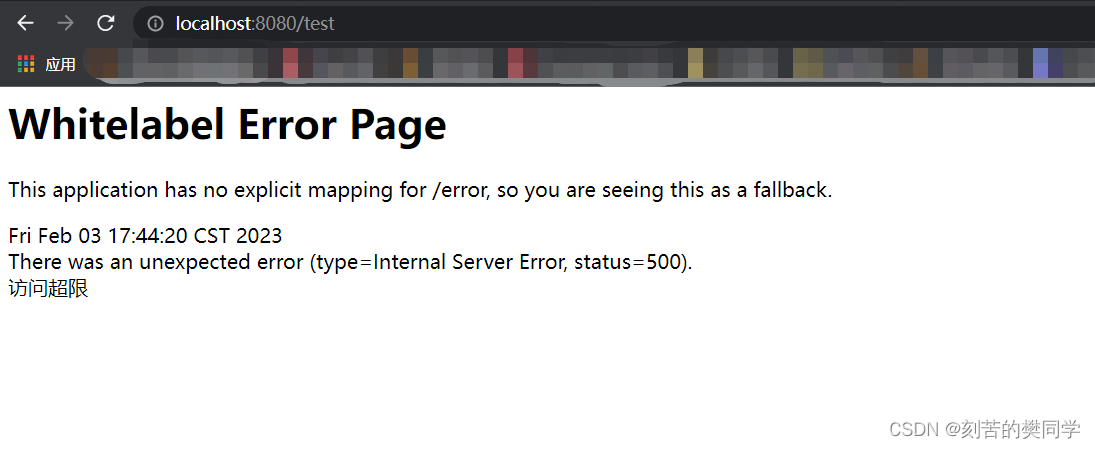springboot使用redis&lua脚本实现分布式限流starter
一,引入依赖
<dependency>
<groupId>org.springframework.boot</groupId>
<artifactId>spring-boot-starter-aop</artifactId>
</dependency>
<dependency>
<groupId>org.springframework.boot</groupId>
<artifactId>spring-boot-starter-web</artifactId>
</dependency>
<dependency>
<groupId>org.springframework.boot</groupId>
<artifactId>spring-boot-starter-data-redis</artifactId>
</dependency>
<dependency>
<groupId>com.google.guava</groupId>
<artifactId>guava</artifactId>
<version>21.0</version>
</dependency>
<dependency>
<groupId>org.apache.commons</groupId>
<artifactId>commons-lang3</artifactId>
</dependency>
二,在application配置文件中添加redis配置
spring:
redis:
host: *****
password:****
port: 6379
# 连接超时时间(毫秒)
timeout: 1000
# Redis默认情况下有16个分片,这里配置具体使用的分片,默认是0
database: 0
三,自定义RedisTemplate
由于后续要使用lua脚本来做权限控制,所以必须自定义一个redisTemplate,此处如果不自定义redisTemplate,则执行lua脚本时会报错。
import org.springframework.context.annotation.Bean;
import org.springframework.context.annotation.Configuration;
import org.springframework.data.redis.connection.lettuce.LettuceConnectionFactory;
import org.springframework.data.redis.core.RedisTemplate;
import org.springframework.data.redis.serializer.GenericJackson2JsonRedisSerializer;
import org.springframework.data.redis.serializer.StringRedisSerializer;
import java.io.Serializable;
@Configuration
public class RedisLimiterHelper {
@Bean
public RedisTemplate<String, Serializable> limitRedisTemplate(LettuceConnectionFactory redisConnectionFactory) {
RedisTemplate<String, Serializable> template = new RedisTemplate<>();
template.setKeySerializer(new StringRedisSerializer());
template.setValueSerializer(new GenericJackson2JsonRedisSerializer());
template.setConnectionFactory(redisConnectionFactory);
return template;
}
}
四,增加限定类型枚举类
自定义一个限定类型枚举类,后续根据类型判断,是根据ip、或是根据类型、或是根据方法名进行限流
public enum LimitType {
//自定义key
CUSTOMER,
//默认,取方法名作为key
OTHERS,
//根据请求者IP作为key
IP;
}
五,增加Limit注解
import java.lang.annotation.*;
import com.eoi.fly.redislimiter.constant.LimitType;
@Target({ElementType.METHOD,ElementType.TYPE})
@Retention(RetentionPolicy.RUNTIME)
@Inherited
@Documented
public @interface Limit {
//资源key
String key() default "";
//时间
int period();
//最多访问次数
int count();
//类型
LimitType limintType() default LimitType.OTHERS;
}
六,增加Limit注解AOP实现类
增加Limit注解的AOP切面,根据注解中的类型,使用lua脚本去redis获取访问次数
import com.eoi.fly.redislimiter.annotaion.Limit;
import com.eoi.fly.redislimiter.constant.LimitType;
import org.apache.commons.lang3.StringUtils;
import org.aspectj.lang.ProceedingJoinPoint;
import org.aspectj.lang.annotation.Around;
import org.aspectj.lang.annotation.Aspect;
import org.aspectj.lang.reflect.MethodSignature;
import org.slf4j.Logger;
import org.slf4j.LoggerFactory;
import org.springframework.beans.factory.annotation.Autowired;
import org.springframework.context.annotation.Configuration;
import org.springframework.data.redis.core.RedisTemplate;
import org.springframework.data.redis.core.script.DefaultRedisScript;
import org.springframework.data.redis.core.script.RedisScript;
import org.springframework.web.context.request.RequestContextHolder;
import org.springframework.web.context.request.ServletRequestAttributes;
import javax.servlet.http.HttpServletRequest;
import java.io.Serializable;
import java.lang.reflect.Method;
import java.util.Collections;
@Aspect
@Configuration
public class LimitInterceptor {
private static final Logger logger = LoggerFactory.getLogger(LimitInterceptor.class);
@Autowired
private RedisTemplate<String, Serializable> limitRedisTemplate;
@Around("execution(public * *(..)) && @annotation(com.eoi.fly.redislimiter.annotaion.Limit)")
public Object interceptor(ProceedingJoinPoint joinPoint){
//获取连接点的方法签名对象
MethodSignature methodSignature = (MethodSignature) joinPoint.getSignature();
//获取方法实例
Method method = methodSignature.getMethod();
//获取注解实例
Limit limitAnnotation = method.getAnnotation(Limit.class);
//注解中的类型
LimitType limitType = limitAnnotation.limintType();
//获取key名称
String key;
//获取限制时间范围
int limitPeriod = limitAnnotation.period();
//获取限制访问次数
int limitCount = limitAnnotation.count();
switch (limitType){
//如果类型是IP,则根据IP限制访问次数,key取IP地址
case IP:
key = getIPAdress();
break;
//如果类型是customer,则根据key限制访问次数
case CUSTOMER:
key = limitAnnotation.key();
break;
//否则按照方法名称限制访问次数
default:
key = StringUtils.upperCase(method.getName());
}
try{
String luaScript = buildLuaScript();
RedisScript<Number> redisScript = new DefaultRedisScript<>(luaScript, Number.class);
/**
* redisScript:构建的lua脚本对象
*
* List<K> keys是key的集合
* Object... args是val的集合
*
* key的集合,在lua中可以使用KEYS[1]、KEYS[2]……获取,注意KEYS必须大写不能拼错
* val的集合,在lua中可以使用ARGV[1]、ARGV[2]……获取,注意ARGV必须大写不能拼错
* 说白了,使用redisTemplate操作lua,也就是传key的集合和val的集合,这一串lua脚本可以保证其原子性的
*
* lua中的redis.call命令就是操作redis的命令,第一个参数就是redis的原始命令,后面的参数就是redis命令的参数
*
* 这里构建的Lua脚本如下
* ====================================================
* local c
* c = redis.call('get',KEYS[1])
* if c and tonumber(c) > tonumber(ARGV[1]) then
* return c;
* end
* c = redis.call('incr',KEYS[1])
* if tonumber(c) == 1 then
* redis.call('expire',KEYS[1],ARGV[2])
* end
* return c;
* ====================================================
*/
Number count = limitRedisTemplate.execute(redisScript, Collections.singletonList(key), limitCount, limitPeriod);
logger.info("Access try count is {} for key = {}", count, key);
if(count !=null && count.intValue() <= limitCount){
return joinPoint.proceed();
}else{
throw new RuntimeException("访问超限");
}
}catch(Throwable e){
if(e instanceof RuntimeException){
throw new RuntimeException(e.getLocalizedMessage());
}
throw new RuntimeException("服务异常");
}
}
/**
* lua限流脚本
* @return
*/
public String buildLuaScript(){
StringBuilder sb = new StringBuilder();
//定义c
sb.append("local c");
//获取redis中的值
sb.append("\nc = redis.call('get',KEYS[1])");
//如果调用不超过最大值
sb.append("\nif c and tonumber(c) > tonumber(ARGV[1]) then");
//直接返回
sb.append("\n return c;");
//结束
sb.append("\nend");
//访问次数加一
sb.append("\nc = redis.call('incr',KEYS[1])");
//如果是第一次调用
sb.append("\nif tonumber(c) == 1 then");
//设置对应值的过期设置
sb.append("\nredis.call('expire',KEYS[1],ARGV[2])");
//结束
sb.append("\nend");
//返回
sb.append("\nreturn c;");
return sb.toString();
}
private static final String UNKONW = "unknown";
/**
* 获取访问IP
* @return
*/
public String getIPAdress(){
HttpServletRequest request = ((ServletRequestAttributes) RequestContextHolder.getRequestAttributes()).getRequest();
String ip = request.getHeader("x-forword-for");
if(ip == null || ip.length() ==0 || UNKONW.equalsIgnoreCase(ip)){
ip = request.getHeader("Proxy-Clent-IP");
}
if(ip == null || ip.length() ==0 || UNKONW.equalsIgnoreCase(ip)){
ip = request.getHeader("WL-Clent-IP");
}
if(ip == null || ip.length() ==0 || UNKONW.equalsIgnoreCase(ip)){
ip = request.getRemoteAddr();
}
return ip;
}
}
七,效果预览
提供一个测试接口,加上限流注解
参数说明:在5秒内,此接口访问不能超过2次(没有指定key,默认方法名作为key,意味着此方法只能在单位时间内共被请求两次;如果指定key为IP,则每个IP在单位时间内请求两次)
@RequestMapping("/test")
@Limit(period = 5,count = 2)
public String test(){
return "Test";
}
前两次请求

超过两次请求后

过了五秒之后,时间刷新,再次请求后

作者:樊同学
-------------------------------------------
个性签名:独学而无友,则孤陋而寡闻。做一个灵魂有趣的人!
如果觉得这篇文章对你有小小的帮助的话,记得在右下角点个“推荐”哦,博主在此感谢!
万水千山总是情,打赏一分行不行,所以如果你心情还比较高兴,也是可以扫码打赏博主,哈哈哈(っ•̀ω•́)っ✎⁾⁾!



 浙公网安备 33010602011771号
浙公网安备 33010602011771号